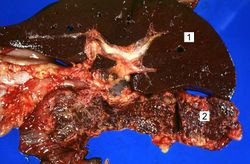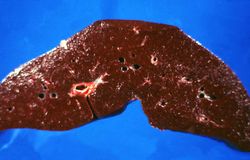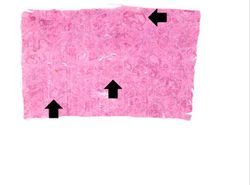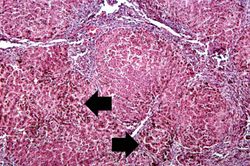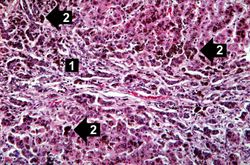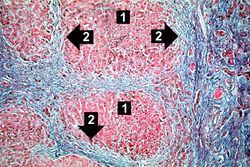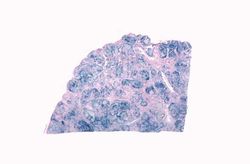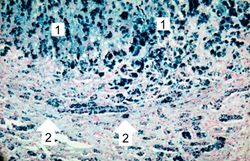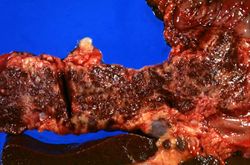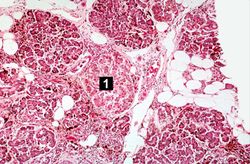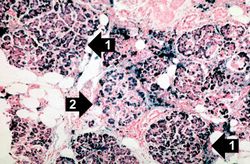Difference between revisions of "IPLab:Lab 5:Hemochromatosis"
(→H&E) |
(→Journal Articles) |
||
| Line 46: | Line 46: | ||
=== Journal Articles === | === Journal Articles === | ||
| + | * Powell LW, Seckington RC, Deugnier Y. [http://ac.els-cdn.com/S014067361501315X/1-s2.0-S014067361501315X-main.pdf?_tid=61a0b7de-07d2-11e6-b26f-00000aab0f02&acdnat=1461251264_8f332714107047706b12570ed99cf384 Haemochromatosis]. ''Lancet'' 2016. | ||
* Ayonrinde OT, Milward EA, Chua AC, Trinder D, Olynyk JK. [http://www.ncbi.nlm.nih.gov/pubmed/18712630 Clinical perspectives on hereditary hemochromatosis]. ''Crit Rev Clin Lab Sci'' 2008;45(5):451-84. | * Ayonrinde OT, Milward EA, Chua AC, Trinder D, Olynyk JK. [http://www.ncbi.nlm.nih.gov/pubmed/18712630 Clinical perspectives on hereditary hemochromatosis]. ''Crit Rev Clin Lab Sci'' 2008;45(5):451-84. | ||
* Bassett ML. [http://www.ncbi.nlm.nih.gov/pubmed/11456037 Haemochromatosis: iron still matters]. ''Intern Med J'' 2001 May-Jun;31(4):237-42. | * Bassett ML. [http://www.ncbi.nlm.nih.gov/pubmed/11456037 Haemochromatosis: iron still matters]. ''Intern Med J'' 2001 May-Jun;31(4):237-42. | ||
Revision as of 18:15, 21 April 2016
Contents
Clinical Summary[edit]
This 61-year-old female was first admitted to the hospital because of ascites and pedal edema. A liver biopsy revealed a marked intracellular accumulation of iron. The serum iron concentration was reported as 220 mcg/dL. On the basis of these studies, the diagnosis of hemochromatosis was made. It should be noted that the patient also exhibited an abnormal glucose tolerance test at this time (following the ingestion of a test dose of glucose, the blood glucose level rose to 290 mg/dL at one hour and remained at this level for the next three hours). Subsequent to the first admission, the patient was admitted on several occasions for ascites. The patient's last admission was necessitated by the development of symptoms and signs of hepatic failure (hepatic coma) characterized by jaundice and coma.
Autopsy Findings[edit]
The liver weighed 820 grams. The cut surface was described as golden-brown in color, having a fine, diffuse nodularity, and being extremely firm in consistency.
Images[edit]
Virtual Microscopy[edit]
H&E[edit]
Liver: Hemochromatosis[edit]
Normal Liver[edit]
Prussian Blue[edit]
Study Questions[edit]
- Compare and contrast the pathogenesis and clinical features of hemochromatosis and Wilson’s disease.
Additional Resources[edit]
Reference[edit]
- eMedicine Medical Library: Hemochromatosis
- Merck Manual: Iron Overload: Hemosiderosis and Hemochromatosis
Journal Articles[edit]
- Powell LW, Seckington RC, Deugnier Y. Haemochromatosis. Lancet 2016.
- Ayonrinde OT, Milward EA, Chua AC, Trinder D, Olynyk JK. Clinical perspectives on hereditary hemochromatosis. Crit Rev Clin Lab Sci 2008;45(5):451-84.
- Bassett ML. Haemochromatosis: iron still matters. Intern Med J 2001 May-Jun;31(4):237-42.
Images[edit]
- PEIR Digital Library: Hemochromatosis Images
- WebPath: Hepatic Pigmentary Disorders
- WebPath: Cellular Accumulations
Related IPLab Cases[edit]
| |||||
Normal serum iron levels are 35 to 160 micrograms/dL.
The glucose tolerance test (GTT) is a measure of active insulin and also reflects the power of normal liver to absorb and store large amounts of glucose. Following the administration of a 75-gram dose of glucose, blood glucose levels should return to normal in less than 3 hours.
After glucose challenge, the blood glucose level should be back to 110 to 180 mg/dL by 2 hours.
Jaundice (or icterus) is a state of hyperbilirubinemia (increased bilirubin in the blood) in which bile pigment is deposited in the skin, mucous membranes, and scleras. This deposition of bile pigment results in a yellow appearance.
A normal liver weighs 1650 grams (range: 1500 to 1800 grams).
Cirrhosis is a liver disease characterized by necrosis, fibrosis, loss of normal liver architecture, and hyperplastic nodules.
